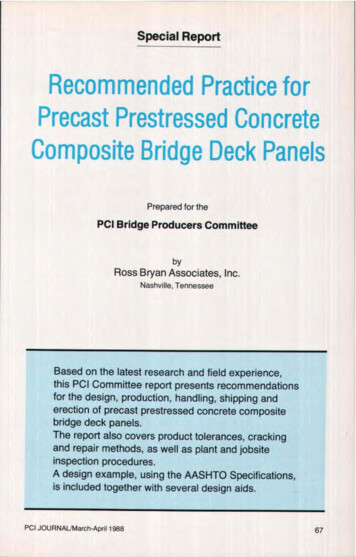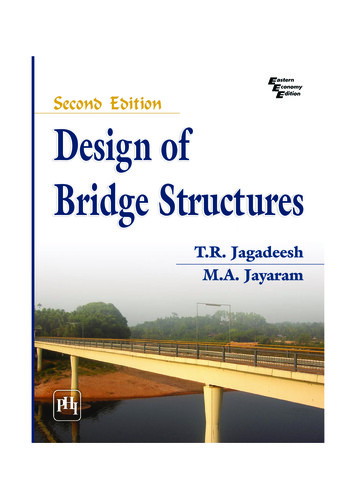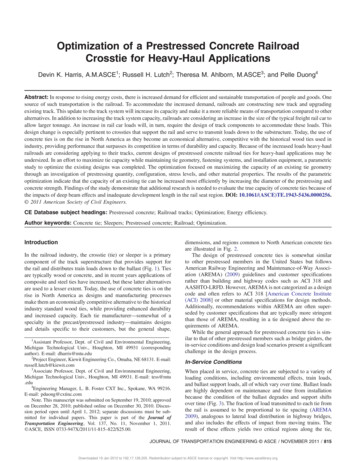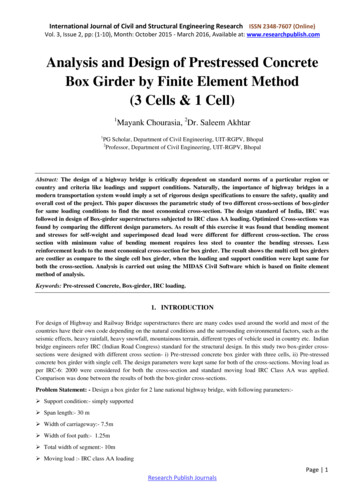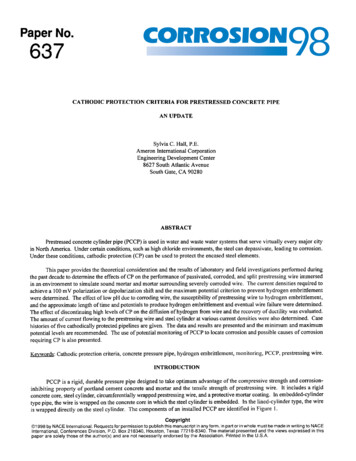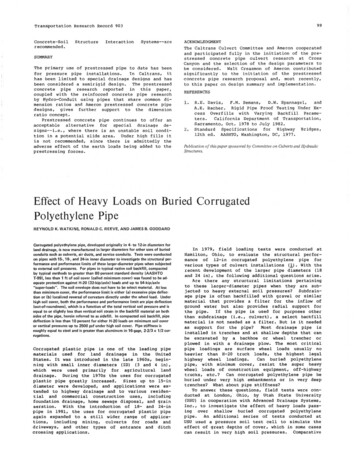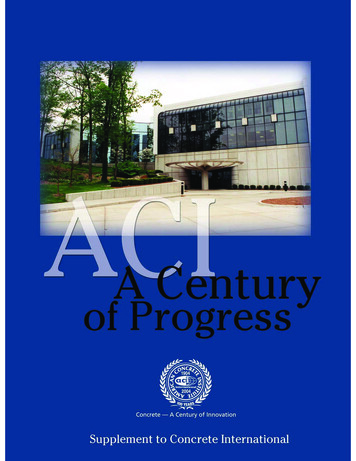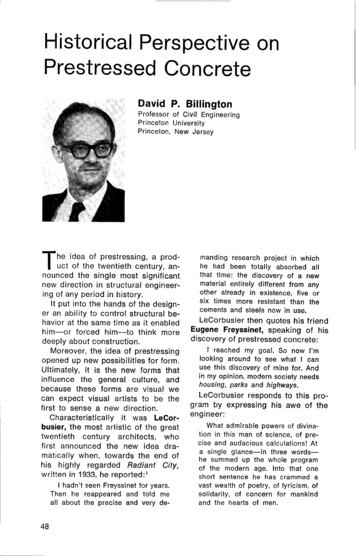
Transcription
Historical Perspective onPrestressed ConcreteDavid P. BillingtonProfessor of Civil EngineeringPrinceton UniversityPrinceton, New JerseyThe idea of prestressing, a product of the twentieth century, announced the single most significantnew direction in structural engineering of any period in history.It put into the hands of the designer an ability to control structural behavior at the same time as it enabledhim—or forced him—to think moredeeply about construction.Moreover, the idea of prestressingopened up new possibilities for form.Ultimately, it is the new forms thatinfluence the general culture, andbecause these forms are visual wecan expect visual artists to be thefirst to sense a new direction.Characteristically it was LeCorbusier, the most artistic of the greattwentieth century architects, whofirst announced the new idea dramatically when, towards the end ofhis highly regarded Radiant City,written in 1933, he reported:'I hadn't seen Freyssinet for years.Then he reappeared and told meall about the precise and very de48manding research project in whichhe had been totally absorbed allthat time: the discovery of a newmaterial entirely different from anyother already in existence, five orsix times more resistant than thecements and steels now in use.LeCorbusier then quotes his friendEugene Freyssinet, speaking of hisdiscovery of prestressed concrete:I reached my goal. So now I'mlooking around to see what I canuse this discovery of mine for. Andin my opinion, modern society needshousing, parks and highways.LeCorbusier responds to this program by expressing his awe of theengineer:What admirable powers of divination in this man of science, of precise and audacious calculations! Ata single glance—in three words—he summed up the whole programof the modern age. Into that oneshort sentence he has crammed avast wealth of poetry, of lyricism, ofsolidarity, of concern for mankindand the hearts of men.
SynopsisThe author, who speaks fluent French andFlemish and spent some of the post World War IIyears in Europe studying engineering, presentsan essay on the origins and development ofprestressed concrete.Three men are singled out for having had themost profound influence on the development ofprestressed concrete—Freyssinet, Magnel,and Finsterwalder.Unquestionably, it was the painstaking pioneeringwork of Freyssinet that convinced theengineering world of the viability of prestressedconcrete.Throughout Freyssinet's life, there is one themethat keeps recurring time and again, namely,"a simplification of forms and an economy ofmeans."Magnel is noted as a great teacher and forcommunicating his ideas on prestressing to theEnglish-speaking world.Finsterwalder pioneered the development of thedouble cantilever method of bridge construction.In retrospect, the author regards the principleof prestressing as the single most importantconcept in engineering history.The beginning of a new way ofbuilding does not usually bring forthsuch a florid outburst. Indeed Freyssinet's own descriptions of hisachievement are entirely different,even though it too contains a passionand a vision.2PCI JOURNAL/September-October 1976I decided to risk all that I had offortune, reputation and strength inmaking the idea of prestressing anindustrial reality. Foreseeing a longand hard struggle and a need forfinancial assistance, I took the precaution of taking out patents.49
The principle of prestressingis the single most importantconcept in the history of engineering.He was at the time the co-managerof the large construction firm of Entreprises Limousin and M. Limousin,considering Freyssinet's ideas unsound, refused to go along. As Freyssinet later described it:Convinced that my attemptswould soon ruin me, he consideredthat his friendship made it a dutyfor him to oppose at all cost whathe considered to be folly. For me,on the contrary, this folly, even if itwas to prove disastrous, was a mission that I had to fulfill whateversacrifices might be required.At the beginning, these sacrificeswere indeed considerable. I lost thebest of friends, a very good financialsituation, the joys given me by myprofession as an engineer and themany collaborators that I hadtrained and loved and worse, whoconsidered me as a deserter.At the age of 50 I was abandoning a life that was already mappedout in order to throw myself intoone that was full of uncertaintiesand perils.To get some idea of the type ofperson who would give up security toseek a new way of building, I shallgive a brief sketch of Freyssinet'spre-1933 background, along withsome assessment of his contributions, and a discussion of how prestressing came to America afterWorld War II and flowered in thenineteen fifties.For this last discussion, I shall focus on the first two major Americanprestressing conferences, one at theMassachusetts Institute of Technology at Cambridge in 1951 and the50other at the University of California atBerkeley in 1957. Much as I wouldlike to explore in detail the wide developments after 1957, I find theselast 20 years too broad for me tomake coherent in a short paper. Instead, I shall end this discourse withseveral contemporary exampleswhose purpose is to show somethingof the continuing nature of the European influence on American construction.It is this last idea, often upsettingto the collective American ego, thatcontains a central cultural meaningof prestressing which springs fromthe fact that the structures of a localecharacterize the local culture perhaps better than any other set of artifacts.To focus on that fact and to narrowmy scope, I shall consider here onlybridges, even though we all knowthat prestressing has broad applications to all kinds of buildings. Still theidea of prestressing arose out ofbridge design and its most impressive forms, from a purely engineeringviewpoint, appear in bridges.Eugene Freyssinet(1879-1962)Eugene Freyssinet was born in1879 in the provinces on the Correzeplateau east of Bordeau in a regionthat he later described:3For many centuries, my ancestors lived clinging to the flanks ofthe steep gorges through whichrush the torrents of the Correzeplateau. A land of forests and impenetrable thickets with a harshclimate and a poor soil, it has,throughout the ages, been the refuge of the unsubdued and therebel.Seeing himself somewhat in thatlight, Freyssinet went on to concludehow his heritage influenced building
and went a long way toward explaining his willingness to risk all to workout his own unconventional ideas forprestressing.Such conditions of backgroundand life have formed a tough, violent and unsociable race, very poorand proud, little inclined to beg assistance and which has wrenched,from its arid soil, all that it neededto live. Universal artisans, thesemen have created for themselves acivilization the main characteristicof which is an extreme concern forthe simplification of forms and economy of means.Although his family moved to Parisin the mid 1880's, he never liked thatcity, the "abominable Paris" hecalled it. It did not fit at all with theartisan world whose great love was"simplification of forms and economyof means."As a student, he was only mediocre and thus rejected in 1898 forprestigious Ecole Polytechniquewhich did, however, accept him thefollowing year "with the not very brilliant position of 161st. ' 4 Graduating19th, he succeeded in being accepted at the Ecole des Ponts et Chaussees where, for the first time, his artisan love of building coincided withthat of his teachers, those "great artisans with an enthusiasm for theirwork Resal, Sejourne, Rabut." It wasthere, in the lectures of CharlesRabut in 1903-04 that the idea ofprestressing first came to him:5Freyssinet's artisan background and love of buildingsinfluenced him to seek anengineering solution to hisstructures through "simplification of forms and economy of means."Eugene Freyssinet—Morethan any other person, itwas the relentless pioneering efforts of this courageous French engineerbuilder who converted theconcept of prestressing into a practical reality.The idea of replacing the elasticforces that are created in the reinforcements of concrete by deflexiondue to loads, by previously imposedand permanent stresses of sufficientvalue, came to my mind for thefirst time during a series of lecturesgiven by Charles Rabut at theEcole des Ponts et Chauss6es in1903-04. These lectures were devoted, on the one hand, to reinforced concrete and on the other,to the systematic study of spontaneous orprovoked deflection instructures.This idea never left him and servedas a guide as his early career focussed on the building of bridges inthe wilderness of south centralFrance, where new ideas could flourish so long as they were based onthat artisan spirit of simplification offorms and economy of means. ThisPCI JOURNAL/September-October 197651
Fig. 1 Le Veurdre Bridge across the Allier River (1910-1911). Spans were67.5-72-67.5 m (22'3 . 238-223 ft). This bridge incorporated the first use ofthrust by jacks at midspan for decentering and also compensating forconcrete creep and shrinkage.was the same region in which GustavEiffel, 40 years before, had workedout new forms and economy in metalbridges.6Two examples of Freyssinet's earlywork demonstrate both this spirit ofform and the guide of prestress, theBernard Arch of 1908 and the bridgeover the Allier at Le Veurdre (seeFig. 1) designed in 1907 and completed in 1912.7Towards 1906-07, the idea of applying precompressions was firmenough in my mind to leac me todraw up a project for a 2500-toncapacity tie linking the two abutments of a 50-m span trial arch.This tie and its arch were cornpleted during the summer of 1903but a study of their deflexion andother observations taught me theexistence of creep in concrete, aphenomenon that was then unknownand even energetically denied byofficial science. In case of inducedpermanent stresses, this was a fearsome unknown. Immediately and ascarefully and completely as possible, I began to study this problembut my efforts were rendered vainby my mobilisation in August 1914.At Le Veurdre, the situation wasmore dramatic and the impact onFreyssinet's vision more lasting. Hehad volunteered to build three52bridges over the Allier River for aprice exactly one-third of that whichhad been bid. As a local engineer ofthe highway department, he had suggested that the bids be rejected andthat he be allowed to act as thebuilder for these bridges followinghis own designs.As Freyssinet later described it:8Fifteen days later, an official letter put me in charge of supervising,on behalf of the Public Authorities,the execution of these bridgeswhose designer I was, for whichwas to be the contractor and theplans of which had never been submitted for anyone's approval. Mercier [Freyssinet's superior] then leftfor Portugal granting me unlimitedcredit out of his funds but withoutgiving me a single man, tool orpiece of advice. Never was a buildergiven such freedom. I was absolutemaster, receiving orders and advicefrom no-one.This rather frightening responsibility had an even more frightening conclus'on when several months aftercompletion of the three-span bridgeat Le Veurdre, the 72m (238 ft) spanarches began to deflect downward atan accelerating rate.9To halt this, all that was requiredwas to remove these joints [at thearch crown] after having, by using
my decentering [sic] jacks in a newapplication, sufficiently raised thecrowns of the arches to do awaywith the major part of the increasesof stress resulting from the deformation of the neutral axis of thearches. There could be no questionof informing the Head Engineer orthe Prefets in order to halt trafficfor they would have panicked andparalysed me and any day thatpassed might bring total collapsefor, at this moment, the strainswere increasing at a frighteningrate.These jacks, the so-called Freyssinet flat jacks, are still used in majorstructures today such as, for example, in the gigantic prestressed CNTower in Toronto; Freyssinet placedthem in the crown hinge and as hewent to describe it:1 Returning to Moulins in the night,I jumped onto my bicycle and rodeto Veurdre to wake up Biguet andthree reliable men. The five of usthen re-inserted the decentering[sic] jacks—I had always kept thispossibility in reserve—and as soonas there was enough daylight touse the level and staffs; we beganto raise the three arches simultaneously. It was market day andevery few minutes we had to interrupt the operation to allow a fewvehicles to pass. However, all endedwell and once more aligned, curedof the illness that had almostkilled it, the Veurdre bridge behavedperfectly until its destruction in thewar in 1940.Writing in 1949, about the companion bridge at Bou'.iron, Freyssinetstated that:"I have just seen it again andeven after [my larger and more recent arch bridges] I consider it.since the disappearance [sic] ofLe Veurdre, to be the finest of mybridges.In the process of creating thesewilderness works, Freyssinet laid theessential basis for prestressingHad Freyssinet never pursued the idea of prestressing,he would still have been regarded (along with RobertMaillart) as one of the twogreatest concrete structuralengineers in the first half ofthe twentieth century.which, however, had to await almost20 years before it became more thanjust a special method of arch construction.During the 1920's Freyssinet designed a series of arch structuresthat made him a world figure, notonly to engineers, but to architectsand artists as well. Had he neverpursued the idea of prestressing, hewould still have been regarded, alongwith Robert Maillart, as one of thetwo greatest concrete structural engineers in the first half of the twentieth century.12The bridge over the Seine at SaintPierre du Vauvray, completed in1922, set the world's span record forconc ete arches at 131 meters (432ft) and followed Freyssinet's methodof jacking the arch apart at the crownto compensate for rib shortening andto lift the structure off the scaffold.Then several years later, he won acompetition for a far larger project,the spanning of the Elhorn river atPlougastel, a project which occupiedhim until 1930. Here, Freyssinet designed three hollow-box arches eachof 186 meters (614 ft) in span (seeFig. 2) and again the arches werejacked apart at their crowns by acontrolled prestress.It was in the course of studies forthis impressive project, that he tookup the study of creep and shrinkagein concrete:13PCI JOURNAL/September-October 197653
Fig. 2. Plougastel Bridge across the Elorn River (1930). Three spans of 180m (584 ft). This bridge had the largest span in reinforced concrete at thattime. . . to know whether one couldcreate permanent prestresses inconcrete in spite of its slow strainsHere was a statement of the problem somewhat more general than thespecific question of designingarches. Thus, in 1926 he organized aset of experiments and began research which was published posthumously as "the Relations Betweenthe Strains and Constitution of Cements and Colloidal Structured Materials" (1926-1929).14Freyssinet's motivation was primarily to understand structures madeof concrete rather than the structureof concrete. Indeed he ends thistreatise with the conclusion that"arches with spans in excess of 1000meters" can be built "at a far lowercost than a suspension bridge of thesame span." 15 His major work didnot, however, lie in that direction.By 1928, with Plougastel well under54way, Freyssinet had recognized themore general significance of prestressing, patenting his ideas inFrance, Britain, and the UnitedStates. 6 For the next 4 years, he devoted his full attention to the potentials of prestressing.In November of 1932, Freyssinetsat down and wrote out his progressat the request of the editor of a newjournal Science et Industrie. In oneof its early issues, dated January1933, Freyssinet's article "New Ideasand Methods" appeared."Beginning with his ideas on the"thermodynamic theory of binders,"he proceeded to analyze the behavior of cement, of concrete, and ofreinforced concrete all from the perspective of a scientist. He describedtests and their results and further explained how stresses over a crosssection arise from shrinkage, fromaxial compression and from bending.Finally, in the fourth of his six chap-
ters, he outlined the "conditions forthe practical use 'of prestressing. "181. Using metals with a very highelastic limit.2. Submitting them to very stronginitial tensions, much greater than50 kg/mm 2 (70,000 psi).3. Associating them with concretes of a very low, constant andwell-known rate of deformability,which offer the additional advantageof very high and regular strengths ofresistance.In present-day terms, Freyssinethad established the need for highstrength steel, for tensioning it to ahigh initial stress, and for highstrength concrete to reduce to a minimum the loss of initial prestress.Although many engineers had proposed the idea of prestress even asfar back as 1886, no one had basedhis idea on a clear understanding ofthe properties of the concrete. Thus,all previous ideas had failed to produce what is now called prestressedconcrete.' 9Freyssinet saw, in general, thewide potential for his idea, whichused what he called treated concrete, but in particular, he had greatdifficulty in establishing any commercial value for it. Partly of course, 1933was the depression, but partly too itwas a genuinely radical idea. Seen asa means for improving arch design,his system of crown jacking was accepted both in Europe and the UnitedStates and used as early as 1930 inOregon;2 but seen as a new material, prestressing found little application in its early years.Freyssinet himself developed afactory at Montargis where he manufactured prestressed concrete poles(see Fig. 3) for electric lines, but hecould not make it succeed. The factory closed not long after his 1933 article appeared and as Freyssinet later put it "our factory was withoutFig. 3. Production of prestressedconcrete poles (1933).customers and was only good forscrap; my wife and I were ruined. "21But not for long, because in 1935he had the opportunity to prove themerits of prestressing by saving theMartime Terminal at Le Havre, partsof which had been settling into theharbor at the alarming rate of about1 in. (2.54 cm) per month.Freyssinet proposed to consolidatethe foundations by prestressing andhis success so convinced the Frenchauthorities that they then supportednumerous large-scale projects between 1935 and 1939 where prestressing proved its practical merit.Freyssinet's retrospective attitude onPCI JOURNAL/September-October 197655
Fig. 4. Armet Bridge across the Marne River (1946). This elegant bridge(built by Freyssinet) was the first major bridge built of precast prestressedsegmental construction.the Marine Terminal restorations isintriguing:22Would I have had the courage totake responsibility had this not constituted for me too, the only chanceof rescuing from oblivion the techniques that had cost me my fortuneand five years of the hardest work . . it was perhaps a chance ofsaving my confidence in myself andin the worth of my effort.Here Freyssinet intimates the rolethat chance plays in providing opportunities even though eventual success surely depended upon thoselong years between 1903 and 1933of direct field experience in structures. But Freyssinet's ability totransform his ideas into new structures lay less in chance or even inlong experience. As he himself saidof those experienced engineers before him who had had the notion ofprestressing:23When by chance, they approached this domain, the absenceof a directing idea prevented thedrawing of conclusions that were56of any practical consequence.This directing idea, for Freyssinet,was in general that simplification offorms and economy of means socharacteristic of his artisan heritage;or as he said once to young engineers:24I loved this art of building whichI conceived in the same way as myartisan ancestors, as a means ofreducing to the extreme, the human toil necessary to attain a useful goal . . . from the bridges ofSeptfonds and LeVeurdre to thoseof the Marne (see Fig. 4) and Caracas . . . (two of his best-knownpost World War II bridge projects)More specifically this love went todefine prestressing as an entirelynew material with the widest possibleapplication. For Freyssinet "the fieldsof prestressed and reinforced concrete have no common frontier;"either a structure is fully prestressedor it is not to be called prestressedconcrete.We do not need to accept that
rigid definition today to recognizehow essential it apparently was toFreyssinet to have this idea of prestressing as a new material in orderto direct his energies into practicalapplications. It was to be crack free;a structure in which the elongationof the high strength steel was to beindependent of the strain in the concrete.One has only to read his writingsto realize that Freyssinet was morean advocate than a teacher; more anoriginator of ideas than one who explains them to others. In his writings,he can even now communicate clearly to us his passion but not so wellhis technical concepts.It took another sort of person tomake clear the simplicity of prestressing and especially to bring it tothe United States. Probably the mostinfluential engineer to do this wasGustave Magnel.Gustave Magnel—This multi-talented Belgian professor combined his design,research, teaching, andwriting skills to communicate his knowledge of prestressed concrete to theEnglish-speaking world.Gustave Magnel(1889-1955)After having graduated from theUniversity of Ghent in Belgium, Magnel spent the years of World War I inEngland where he helped train British engineers in reinforced concrete.Aside from establishing his teachingtalent, this experience gave him afull command of the English language .25In 1922, Magnel was appointed alecturer at Ghent to teach reinforcedconcrete, in 1927 named docent, andin 1937 made professor and directorof the Laboratory for Reinforced Concrete. 26 Although French was hismother tongue, he switched histeaching to Flemish (Dutch) when theUniversity at Ghent changed languages in the late 1920's. He couldthus teach fluently in at least threelanguages.In addition to teaching, he was aprolific writer, an experienced designer, and an able researcher bythe time the second World War isolated him in Belgium. During thoseyears then he began to exploreFreyssinet's ideas and to carry outsome research on his own.Thus, when the war ended andbuilding in Europe began again at anaccelerating rate, Magnel was one ofthe few engineers with long experience in reinforced concrete, who atthe same time had mastered theideas of prestressing, and what iseven more important, who was ideallysuited to communicate those ideasto the English-speaking world.He had already written at leastnine books, some of which had gonethrough three editions when, in 1948,he wrote Le Beton Precontraintwhich was immediately published inPCI JOURNAL/September-October 197657
The single most significantcharacteristic of Magnel washis ability to communicate asexemplified by his teachings,and prolific writings—andmore importantly to translatethose ideas to the Englishspeaking world.Freyssinet and Magnelin ContrastMagnel's books and writings(English editions) clearly explain the idea of prestressingin terms of structural mechanics, whereas Freyssinetin his 1949 article gives amore descriptive, but lesspractical, discussion.2'Freyssinet's writing is morestimulating to an experienced engineer, Magnel'smore useful to one unacquainted with prestressing.Whereas Freyssinet sawprestressed concrete as acompletely new material, essentially different from reinforced concrete, Magnel emphasized rather the simplicityof design as it related tothe, by then accepted, ideasabout reinforced concrete.Freyssinet exhorts the designer to rethink concretestructures from a totally newperspective while Magneldemonstrates how procedures already known by apracticing engineer in 1948can be used to design members of prestressed concrete.58English, went through three Britisheditions and was also later publishedin the United States.27But the single most significantcharacteristic of Magnet was his ability to teach. As one of the few Americans who followed a complete sequence of his courses at Ghent,can state that he was the best teacher I ever had. His efforts in teaching,writing and research were to simplify. As he wrote in his book on prestressing:29In the writer's opinion this problem (of computing the ultimatestrength of prestressed beams)should be solved with the leastpossible calculations, as calculations are based on assumptionswhich may lead to wrong results.His suspicions of complex calculations was balanced by his confidencein tests and full-scale observations.It is therefore proposed to useknown experimental results to produce a reasonable formula, avoiding the temptations to confuse theproblem with pseudo-scientific frills.It was this drive for simple, practical formulas and explanationswhich, combined with his long experience, lent credibility to Magnel'senthusiasm of prestressing. Thus,when the opportunity arose in 1948to explore the possibility of building amajor public structure of prestressedconcrete, it was not surprising thatthe American engineers involvedwould turn to the Belgian, Magnet,for a design.The Walnut Lane BridgeIn a speech given at the FirstUnited States Conference on Prestressed Concrete, Samuel S. Baxter,later to become president of theASCE, stated that had the originalarch design for the new Walnut LaneBridge been bid below the engineers estimate:3o
It is also quite possible that thisFirst Conference on PrestressedConcrete might not now be in session. . .His claim was probably correct,even though prestressing was already being tried out by 1951 andsome conference would soon havebeen arranged thereafter. Still thisPhiladelphia bridge served to characterize the potential for prestressedconcrete because of its large-scale,160-ft main spans, because of itsconstruction economy, and becauseof its acceptance, not only by city engineers, but also by a powerful cityArt Jury, two types of people normally associated with traditional attitudes.As Baxter explained it, the stonefaced arch design of 1974 obtaineda low bid of 1,047.790 compared tothe engineers estimate of 900,000.By law, if the low bid exceeds theestimate, it is rejected. Thus, thecity engineers began to search foranother solution, of which two arose.The first was a plan to remove thestone facing which in the low bidamounted to the astounding sum of 486,490! Here the Art Jury objectedto the mass of an unfaced arch. Thesecond solution suggested itself almost by accident.31The Bureau of Engineering, Surveys and Zoning at that time wasconstructing large circular sludgetanks at its new Northeast Treatment Works. These were being builtby the Preload Corporation of NewYork (sub- contractors for VirginiaEngineering Company of NewportNews, Virginia), using the prestressing technique of winding wiresaround a thin core. The chance remark of Mr. E. R. Schofield, whowas at that time Chief of the Design Division of the Bureau of Engineering, Surveys and Zoning, to arepresentative of the Preload Corporation, led to a decision to ex-plore the use of prestressed concrete for this bridge. Among thosewith whom Mr. Schofield talkedwere Mr. L. Coff, Consulting Engineer of New York, and representatives of the Preload Corporation.Contracts were also made with Professor Gustave Magnel in Belgium.The city decided to follow Magnel's ideas for a prestressed concrete girder design but they still hadto convince the Art Jury. Baxter records their response, surely one ofthe most historcally significant eventsin the relationship between structureand aesthetics.32The Art Jury, however, on seeingthe preliminary sketches for the newbridge agreed that the comparatively slim lines of the new bridgewould not require stone facing.Thus, a major structure in one ofPhiladelphia's most elegant naturalsettings became possible because itsappearance was pleasing enough topermit it to be economical. The lowbid in 1949 was 597,600 for thebridge and 100,783 for the approaches; Baxter estimated that thisamounted to a "net minimum saving(of) approximately 76,000" over anarch without stone facing in 1949.33Moreover, the Art Jury would probably have required a rubbed finish onthe bare concrete arch, adding atleast 40,000 and making the prestressed solution a minimum of 116,000 less than the arch. The saving ofover 16 percent clearly made thislarge-scale work possible and influenced the way prestressing enteredAmerican practice. Of the thirty papers presented at MIT in August of1951, five were by people directlyconnected to the Walnut Lane Bridge.Another feature of this bridge wasthe full-scale test to destruction ofone of its 160-ft (48.5 m) long girders.Although, perhaps, unnecessary inprinciple, this test did serve dramatically to demonstrate, in practice,PCI JOURNAL/September-October 197659
Fig. 5. Artist's painting of Walnut Lane Bridge after completion (1951).Particulars ofWalnut Lane BridgeThe first prestressed concretebridge to be constructed in theUnited States was Philadelphia'sWalnut Lane Bridge. This bridge,which was conceived and designedby Gustave Magnel, was completedii 1950. It contains three simplysupported girders with a centerspan of 155 ft and two end spansof 74 ft each. The girders are (shaped, 79 in. deep with 52-in.flanges.The flanges in the center span arebutted, but in the end span thebeams are placed 8 ft 8 in. on centers and the slab cast-in-place. Thegirders were tensioned by the Magnel method, i.e., using two strandsat a time.The Preload Co. of New Yorkerected this structure. The girderswere cast on falswork at the bridgesite and moved horizontally intoposition on the foundation.60and in front of at least 500 engineers,the high overload capacity of thebridge b
The author, who speaks fluent French and Flemish and spent some of the post World War II years in Europe studying engineering, presents an essay on the origins and development of prestressed concrete. Three men are singled out for having had the most profound influence on the development of prestressed concrete—Freyssinet, Magnel, and .

